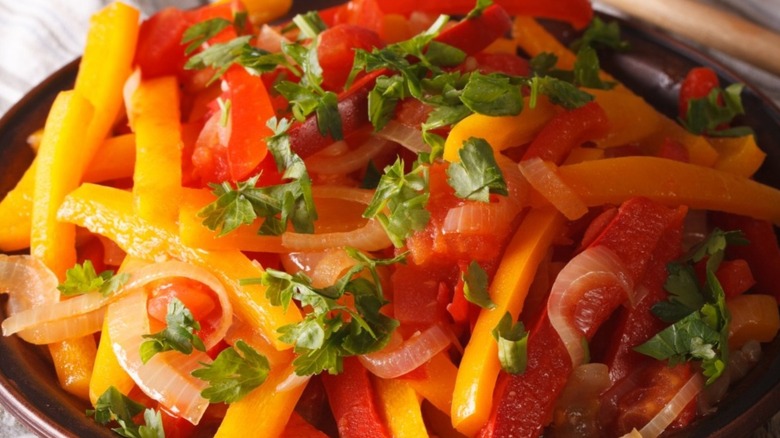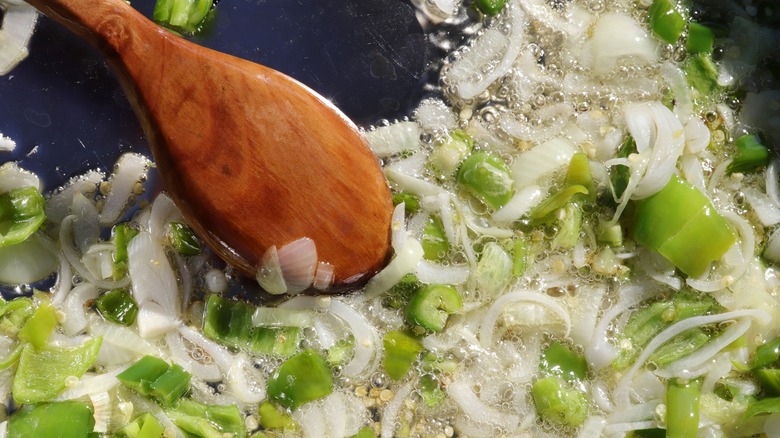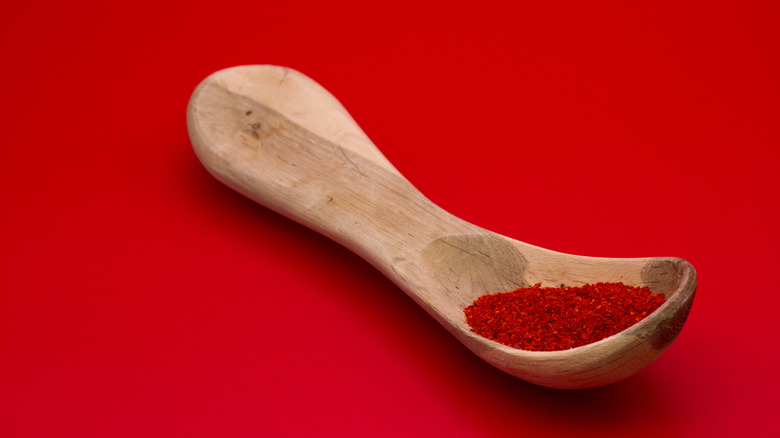What Is Piperade And What Does It Taste Like?
Piperade. It sounds like a refreshing summertime beverage, but it's not. Instead, in its simplest form, piperade is a rustic Basque blend of tomatoes, onions, green peppers, and Espelette pepper, according to iFood.TV. Sometimes called piperrada, says the James Beard Foundation, the dish originated in the Basque Country, an autonomous community of Spain straddling the border between France and Spain on the Bay of Biscay (via The Land of the Basques).
Piperade is typically a mid- to late-summer appetizer, prepared when fresh tomatoes and green peppers are abundant. A seasoning made from dried, crushed Espelette peppers (from the town of Espelette in France) gives the dish a touch of heat and is the key ingredient in authentic piperade. The satisfyingly savory dish with a touch of heat originated in the 19th century. In its most basic preparation, fresh-from-the-garden tomatoes and green bell peppers are sautéed in olive oil along with onion, garlic, salt, pepper, and piment d'Espelette, explains New York Times Cooking. As the vegetables break down, piperade takes on an almost stew-like consistency. Served hot with warm crusty bread, it is a meal in itself, but it is also commonly used as a hot or cold condiment.
How to make piperade
Preparations for piperade vary by region. The traditional (and original) Basque version consists of onions, tomatoes, green peppers, and piment d'Espelette. Similar in taste to smoked paprika, piment d'Espelette is made from a moderately hot red pepper cultivated in the formerly Basque region of France, according to iFood.TV. Heartier versions of piperade incorporate eggs, ham, and garlic into the mix. Although it's an easy dish to prepare — it basically comes down to slicing and sautéing some fresh vegetables — there's debate about the "right" way to prepare the tomatoes. According to Regions of France, some cooks say it's imperative to include the tomato juice that spills from the chopped tomatoes, while others insist on using only the tomato flesh.
Another recipe in New York Times Cooking suggests blanching the tomatoes before giving them a rough chop. It's a hit with readers, garnering five stars and several comments including a note from Joan M, who, while acknowledging that she incorporates a few tweaks she learned from her French daughter-in-law, advised, "It is a good idea to make a large batch when making piperade because it is even better the next day."
What's the most important ingredient in authentic piperade?
The key to authentic piperade? Piment d'Espelette. Sure, you can substitute paprika, says Chili Pepper Madness, but eliminating the essence of Espelette pepper (or Capsicum annuum) amounts to nixing piperade's Basque roots. In fact, the long red pepper is so tied to French Basque culture that it's protected by the government. It earned AOC status (appellation d'origine contrôlée or controlled designation of origin, according to Difford's Guide) in 2000, giving it equal footing with the likes of Champagne from Champagne and Roquefort from Roquefort. But growing location alone isn't enough to qualify piperade's key ingredient for AOC status. In order to label their peppers Espelette, producers have to abide by stringent standards for growing conditions, including natural elements that affect flavor, like climate, soil, and geology.
Despite all these rules and regulations, Espelette peppers aren't native to France. They're actually a variety of peppers that 16th-century explorers brought to Europe from Central and South America. Still, they're an important contributor to the local Basque economy, so much so that the town of Espelette throws an annual party in their honor. The Espelette Pepper Festival takes place each year in October, the perfect time of year to savor the fall harvest with a spicy plate of piperade.
Nutritional information about piperade
Piperade is a flexible dish in terms of customization. While the basic preparation calls for just a few nutritious ingredients, it's easy to dress up or down. One of Food Network's recipes takes basic piperade and turns it into a full-blown meal with cooked ham and eggs. Chowhound takes it a step further, using ham-filled pipérade to braise a whole chicken.
In its more basic vegetarian form, piperade is reasonably low in calories. According to Nutrionix, a ½-cup serving prepared according to traditional methods contains about 100 calories, 219 milligrams of sodium, and 7.5 grams of carbohydrates. It's a decent source of vitamin C, incorporating more than 63% of the USDA's daily recommended allowance, as well as about 12% of the daily recommended intake of Vitamin A. Of course, nutritional values will vary widely depending on added proteins and ingredients.
Where to buy piperade
While most people may prefer to cook their own piperade, others might appreciate the convenience of buying it in stores for a quick appetizer or thoughtful gift. One French retailer, for example, carries a jarred version (via Jean Martin). Otherwise, piperade is such a bare-bones dish that you're likely to find almost all of the main ingredients — onions, green peppers, tomatoes, garlic, and olive oil — at your local grocery store.
Of course, the signature ingredient and the basis of its Basque-ness — the piment d'Espelette — may be harder to locate. If you want to create something piperade-adjacent, go ahead and substitute smoked paprika, per Chili Pepper Madness. If authenticity is important to you, however, and you don't mind searching a bit, do your best to find the real piment d'Espelette. You'll have luck online at retailers including Amazon, World Spice Merchants, and Market Hall Foods, according to our research.
There's one more option for those craving piperade: ordering it at a restaurant. If you happen to be in the San Francisco area, one local eatery has built its reputation on piperade. The chef-owner, Gerald Hirigoyen, grew up in the Basque Country, according to Great Chefs, and specializes in the flavors of the region. Piperade is on the menu, and the name of the restaurant is easy to remember: It's Piperade.




